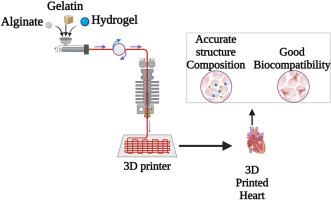3D and 4D printed materials for cardiac transplantation: Advances in biogenerative engineering
Q1 Computer Science
引用次数: 0
Abstract
The most common reason for death worldwide is cardiovascular problems, and current treatments including medication, surgery, and heart transplants have disadvantages. Both 3D and 4D printing technologies are being investigated due to the demand for sophisticated solutions in cardiac care. With the use of these technologies, it may be possible to construct intricate circulatory systems, provide individualized care, and find solutions to problems like organ shortages and immune rejection. The paper focuses on various bioprinting methods that may be used in cardiac tissue engineering to create biomimetic structures, improve vascularization, and construct functional heart tissues using 3D and 4D manufacturing. The advancement of 3D and 4D printing procedures has led to substantial advancements in heart tissue engineering by offering precise and customized solutions. These technologies make it possible to fabricate intricate cardiovascular models along with medical equipment, which improves surgical planning and allows for patient-specific therapies. There are still challenges to be solved, primarily in the areas of realistic vascularization and the use of biomaterials that resemble natural cardiac tissue in terms of their mechanical and chemical properties. Technologies for 3D and 4D printing hold promise for resolving major issues with heart transplantation, namely donor scarcity and rejection. Improving vascularization along with biomaterial incorporation for therapeutic applications has to be the main goal of future research.

用于心脏移植的 3D 和 4D 打印材料:生物生成工程的进展
全球最常见的死亡原因是心血管问题,而目前的治疗方法包括药物、手术和心脏移植,但都存在缺陷。由于心脏护理领域对复杂解决方案的需求,3D 和 4D 打印技术正在接受研究。利用这些技术,有可能构建复杂的循环系统,提供个性化护理,并找到解决器官短缺和免疫排斥等问题的方法。本文重点介绍了可用于心脏组织工程的各种生物打印方法,以利用三维和四维制造技术创建生物仿生结构、改善血管化并构建功能性心脏组织。三维和四维打印技术的进步提供了精确和定制化的解决方案,从而大大推动了心脏组织工程的发展。这些技术使复杂的心血管模型和医疗设备的制造成为可能,从而改善了手术规划,实现了针对患者的治疗。目前仍有一些挑战有待解决,主要是在现实血管化和使用在机械和化学特性方面与天然心脏组织相似的生物材料方面。三维和四维打印技术有望解决心脏移植的主要问题,即供体稀缺和排斥反应。改善血管化并将生物材料纳入治疗应用必须成为未来研究的主要目标。
本文章由计算机程序翻译,如有差异,请以英文原文为准。
求助全文
约1分钟内获得全文
求助全文
来源期刊

Bioprinting
Computer Science-Computer Science Applications
CiteScore
11.50
自引率
0.00%
发文量
72
审稿时长
68 days
期刊介绍:
Bioprinting is a broad-spectrum, multidisciplinary journal that covers all aspects of 3D fabrication technology involving biological tissues, organs and cells for medical and biotechnology applications. Topics covered include nanomaterials, biomaterials, scaffolds, 3D printing technology, imaging and CAD/CAM software and hardware, post-printing bioreactor maturation, cell and biological factor patterning, biofabrication, tissue engineering and other applications of 3D bioprinting technology. Bioprinting publishes research reports describing novel results with high clinical significance in all areas of 3D bioprinting research. Bioprinting issues contain a wide variety of review and analysis articles covering topics relevant to 3D bioprinting ranging from basic biological, material and technical advances to pre-clinical and clinical applications of 3D bioprinting.
 求助内容:
求助内容: 应助结果提醒方式:
应助结果提醒方式:


